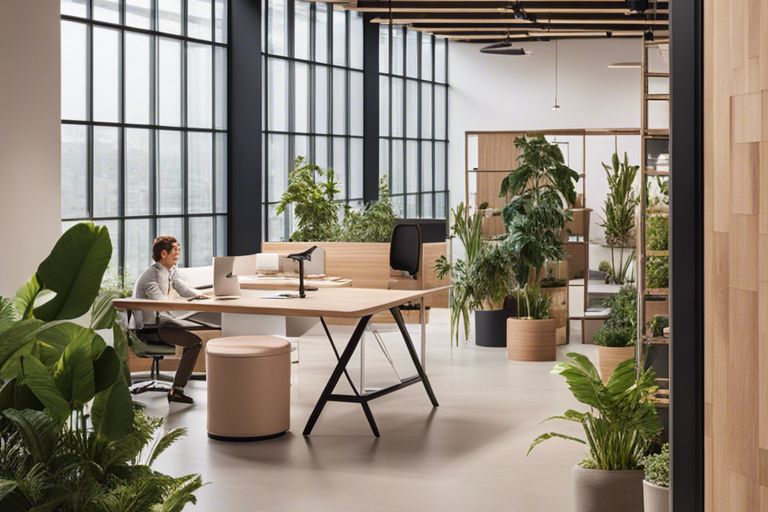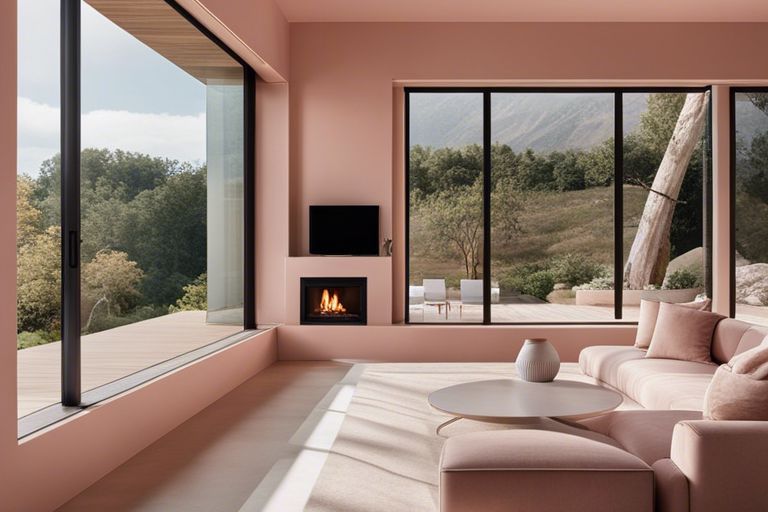It’s not just about aesthetics–incorporating biophilic design elements into your space can encourage physical activity and movement. By bringing nature indoors through natural light, greenery, and natural materials, biophilic design creates a more stimulating environment that promotes wellness and vitality. In this post, discover how biophilic design can inspire you to move more and lead a healthier lifestyle.
Key Takeaways:
- Biophilic design encourages movement: Incorporating natural elements like plants, natural light, and water features in architecture promotes physical activity by enticing people to move around and explore their environment.
- Nature boosts mental well-being: Exposure to nature elements within built environments has been linked to reduced stress levels, increased focus, and improved cognitive function, all of which can enhance motivation for physical movement and exercise.
- Integration of green spaces: Including green spaces such as gardens, courtyards, or outdoor recreation areas in design plans can inspire people to engage in activities like walking, jogging, or outdoor yoga, promoting a healthier lifestyle and overall well-being.
The Concept of Biophilic Design
Before delving into how biophilic design promotes physical activity and movement, it’s important to understand the concept itself. Biophilic design is an innovative approach that seeks to connect people with nature through the design of spaces where we live, work, and play. By incorporating natural elements such as plants, natural light, water features, and organic materials into our built environments, biophilic design aims to create harmonious and sustainable spaces that enhance our well-being.
Definition and Principles
With a focus on fostering a deep connection to nature, biophilic design is rooted in the idea that humans have an innate affinity for nature, known as biophilia. This design approach integrates natural elements, processes, and patterns into the built environment to create spaces that support human health and well-being. The principles of biophilic design include incorporating natural light, views of nature, natural materials, and vegetation to create spaces that mimic the natural world.
Historical Background and Evolution
Definition: Biophilic design has its roots in the biophilia hypothesis proposed by biologist E.O. Wilson, which suggests that humans have an instinctive bond with nature and other living organisms. This concept has influenced architects, designers, and urban planners to create spaces that enhance human health and well-being by reconnecting people with nature.
Biophilic design has evolved over time to address the growing disconnect between humans and the natural world due to urbanization and technological advancements. As our living and work environments become more urbanized and technology-driven, incorporating biophilic design principles becomes crucial for promoting physical activity, health, and overall well-being.
The Importance of Physical Activity
Some studies have shown that incorporating biophilic design elements in architecture can significantly promote physical activity and movement in your daily life. By seamlessly integrating natural elements like sunlight, greenery, and natural materials into your built environment, you are more likely to engage in physical activities and maintain a healthier lifestyle.
Health Benefits of Regular Exercise
An active lifestyle not only keeps you physically fit but also has numerous health benefits. Regular exercise can improve cardiovascular health, strengthen muscles and bones, boost your immune system, and contribute to better mental well-being. By incorporating biophilic design principles in your surroundings, you are more inclined to engage in physical activities that can lead to improved overall health.
Sedentary Lifestyle Epidemic
Exercise is necessary to counter the sedentary lifestyle epidemic that is prevalent in today’s society. With the rise of technology and office jobs that require long hours of sitting, it’s easy to fall into a sedentary routine that can be detrimental to your health. The negative effects of prolonged sitting include increased risk of obesity, heart disease, diabetes, and other health issues.
Benefits of regular physical activity, with the incorporation of biophilic design elements in your environment, can help combat the dangers associated with a sedentary lifestyle. By encouraging movement and physical engagement through thoughtful design, you can take proactive steps towards a healthier and more active lifestyle.

How Biophilic Design Encourages Movement
Natural Light and Ventilation
Designing spaces with ample natural light and ventilation can significantly impact your physical activity levels. When your environment is well-lit and properly ventilated, you are more likely to feel energized and motivated to move around. Natural light also helps regulate your circadian rhythm, promoting better sleep and overall well-being.
Connection to Nature and Outdoor Spaces
Connection to nature and outdoor spaces is a key element of biophilic design that encourages physical activity. By incorporating elements like greenery, water features, and outdoor seating areas, you are more inclined to step outside and engage in movement. Additionally, access to outdoor spaces can inspire activities like walking, cycling, or simply taking a break in a natural setting.
For instance, having a green rooftop garden or a biophilic courtyard in your workplace can provide opportunities for physical activity during breaks or lunchtime. You may find yourself taking a short walk or stretching outdoors, rather than staying sedentary at your desk all day.
Incorporating Active Transportation Options
One way that biophilic design encourages movement is by incorporating active transportation options such as bike racks, walking paths, or proximity to public transportation. By providing easy access to these modes of transportation, you are more likely to choose active ways of getting around, increasing your daily physical activity levels.
Creating a walkable and bike-friendly environment not only promotes physical movement but also reduces dependence on cars, leading to a more sustainable and eco-friendly lifestyle. This design approach can positively impact both your health and the environment, encouraging you to incorporate more movement into your daily routine.
Design Elements that Promote Physical Activity
Stairwells and Vertical Movement
The design of stairwells can significantly impact physical activity levels within a building. By incorporating inviting and visually appealing staircases, you are more likely to choose stairs over elevators. This encourages movement throughout the day, leading to increased physical activity.
Open Floor Plans and Flexible Spaces
Promote physical activity through open floor plans and flexible spaces. By providing areas that can easily be transformed for different activities, you are encouraged to engage in various forms of movement. These dynamic spaces promote creativity and flexibility in your workout routines.
Activity: Furthermore, open floor plans can facilitate group exercises or yoga classes, fostering a sense of community and motivation to stay active.
Accessible Fitness Areas and Equipment
Stairwells can also serve as exercise zones in biophilic design. With strategically placed fitness equipment along staircases, you can easily incorporate mini workouts into your daily routine. These accessible fitness areas promote incidental exercise and make staying active effortless.
Elements: Having exercise equipment readily available in communal areas encourages spontaneous physical activity and reinforces the importance of movement in your daily life.
The Role of Biophilia in Reducing Sedentary Behavior
Despite the modern sedentary lifestyle that many people lead, incorporating biophilic elements into your environment can play a crucial role in reducing sedentary behavior. Biophilic design, which integrates natural elements and patterns into man-made spaces, has been shown to have numerous benefits for physical and mental well-being.
Biophilic Elements and Stress Reduction
Stress is a major contributor to sedentary behavior, as people often turn to activities like binge-watching TV or scrolling through social media as a way to cope. By incorporating biophilic elements such as natural light, indoor plants, and views of nature into your surroundings, you can create a calming environment that promotes relaxation and reduces stress levels. Studies have shown that exposure to nature, even in small doses, can have a significant impact on lowering cortisol levels and improving overall well-being.
Improving Mental Health through Nature Connection
Sedentary behavior is closely linked to mental health issues such as anxiety and depression. However, by fostering a stronger connection to nature through biophilic design, you can improve your mental health and well-being. Simply incorporating elements like natural materials, water features, or nature-inspired artwork into your workspace or home can help reduce feelings of isolation, boost mood, and increase overall contentment.
A study published in the Journal of Environmental Psychology found that office workers with views of nature reported higher levels of job satisfaction and lower levels of stress compared to those without access to natural elements in their work environment. This highlights the powerful impact that biophilic design can have on mental health outcomes.
Boosting Productivity and Focus
Reducing sedentary behavior is not only crucial for physical health but also for maintaining productivity and focus throughout the day. Biophilic design has been shown to enhance concentration, creativity, and cognitive function. By incorporating elements such as natural textures, colors, and patterns into your surroundings, you can create a space that energizes and inspires you to stay active and engaged.
Role of biophilic design in reducing sedentary behavior cannot be overstated, as it provides a multifaceted approach to creating environments that promote physical activity, mental well-being, and overall health.
Real-World Applications of Biophilic Design
Offices and Workspaces
Applications of biophilic design in offices and workspaces can significantly impact your physical activity and movement. By integrating natural elements such as plants, natural light, and water features, you are more likely to feel energized and motivated throughout the day. Studies have shown that access to views of nature can reduce stress levels and increase productivity, prompting you to move around more frequently during your work hours.
Schools and Educational Institutions
The design of educational institutions with biophilic elements can also play a crucial role in promoting physical activity among students. Green spaces, natural textures, and outdoor learning environments can inspire movement and exploration, enhancing students’ overall well-being and academic performance.
Including features like gardens, natural playgrounds, and green walls in school designs can encourage physical activity and exposure to nature, fostering a healthier and more engaged student body.
Healthcare Facilities and Hospitals
Biophilic design in healthcare settings has been shown to have a positive impact on both patients and healthcare providers. Natural elements such as healing gardens, views of nature, and biophilic artwork can reduce stress, improve recovery times, and increase overall well-being for patients. For healthcare staff, a well-designed environment can enhance job satisfaction and decrease burnout, leading to more active and engaged care.
On top of promoting physical activity and movement, biophilic design in healthcare facilities can contribute to a holistic healing approach, supporting patients’ mental, emotional, and physical well-being.
Another benefit of biophilic design in healthcare facilities is the potential to reduce the need for pain medication and decrease anxiety levels in patients, creating a more supportive and healing environment.
Conclusion
Taking this into account, Biophilic design plays a crucial role in promoting physical activity and movement by incorporating natural elements into indoor spaces, encouraging people to move and interact with their environment. By creating connections to nature within built environments, biophilic design can increase overall well-being and productivity while also promoting a more active lifestyle.
Next time you find yourself in a space with biophilic design elements, take a moment to appreciate how they inspire movement and physical activity. Whether it’s a green wall, natural light, or indoor plants, these elements can help you stay active and engaged throughout your day. Embrace the benefits of biophilic design and let nature enhance your surroundings to promote a healthier and more active lifestyle.
FAQ
Q: What is biophilic design?
A: Biophilic design is an innovative approach to creating spaces that incorporate elements of nature to enhance human well-being. It aims to connect people with nature in the built environment.
Q: How does biophilic design promote physical activity?
A: Biophilic design elements such as natural light, indoor plants, and views of nature have been shown to increase physical activity levels. These elements create spaces that encourage movement and increase energy levels.
Q: What are some examples of biophilic design features that promote movement?
A: Examples of biophilic design features that promote movement include green roofs, walking trails, indoor gardens, and natural materials like wood and stone. These features create environments that inspire people to be more active and engaged.

